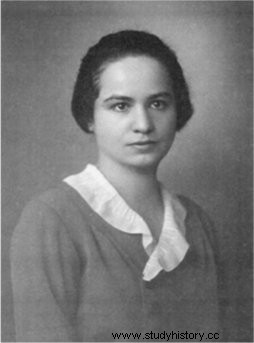Austrian physicist, Marietta Blau (1894 – 1970) received several awards for his pioneering work on photographic methods of particle detection.
Physicist

Daughter of Florentine Goldzweig and Mayer Blau, a lawyer, Marietta Blau was born into a middle-class Jewish family in Vienna on April 29, 1894. Her father encouraged her to study and, after obtaining a certificate of studies in a high school for girls in Vienna, Marietta studied mathematics and physics at the University of Vienna – where Lise Meitner had studied fifteen years earlier – between 1914 and 1918. In March 1919, she defended her thesis on the absorption gamma rays.
Marietta took a position at the radiology institute of the central hospital in Vienna, before moving to Berlin to find a job in an x-ray tube factory. She later left this position to become an assistant at the medical institute of the young Johann Wolfgang Goethe University in Frankfurt am Main, created a few years earlier. In 1923, to be closer to her sick mother, Marietta returned to Vienna; there she worked as a volunteer at the Radium Research Institute in Vienna, where she remained until 1938, even though her requests to be officially employed remained a dead letter.
Disintegrating Stars
During these years, Marietta Blau focused in particular, with her student Hertha Wambacher, on photographic methods for detecting charged particles. In particular, they observe the traces left by protons on photographic emulsions. In 1937, Hertha and Marietta obtained the opportunity to expose plates to cosmic radiation for five months on the Hafelekarspitze, an Austrian mountain rising to 2,334 meters. They observe reactions between the particles of cosmic rays and the photographic emulsion, which compose star-shaped traces from the point of reaction; they call them "decay stars".
As early as 1937, Marietta Blau and Hertha Wambacher received the Lieben Prize in 1937, an Austrian prize rewarding young scientists in physics, chemistry or molecular biology, for their work on decay stars. Marietta doesn't get a job yet.
After the Anschluss
In 1938, Nazi Germany annexed Austria during the Anschluss and Marietta Blau had to leave her country, which dealt a severe blow to her work and her research. After a first time in Oslo, Norway, Marietta moved to Mexico City where she obtained, following the intercession of Albert Einstein in her favour, a position as a teacher at the National Polytechnic Institute. Her research conditions there are complicated, but she still publishes six articles on radioactive rocks in a Mexican scientific journal.
In 1944, her mother died and Marietta moved to New York in the United States, near one of her brothers. She first worked for industry and then, from 1948, for Columbia University in New York. She then worked on nuclear energy at the Brookhaven National Laboratory (Long Island) and then at the University of Miami. She continues her work on photographic methods for detecting charged particles.
In 1950, Marietta Blau was nominated for the Nobel Prize in Physics by the famous physicist Erwin Schrödinger; she will be named three times in all, twice by Schrödinger and once by the physicist Hans Thirring, but will not obtain the Nobel Prize.
Return to Austria
In 1960, as her health deteriorated, Marietta returned to Vienna where she could benefit from less expensive care than in the United States. There she resumed her work – still a volunteer – at the radium research institute. The same year, she was asked by the European Council for Nuclear Research (CERN) and took over the management of a working group analyzing photographs of traces of particles resulting from CERN experiments.
In 1962, Marietta was the first woman to receive the Erwin-Schrödinger Prize, an award from the Austrian Academy of Sciences in the fields of mathematics and natural sciences.
In 1970, Marietta Blau died of cancer due to her exposure to radioactive substances.
